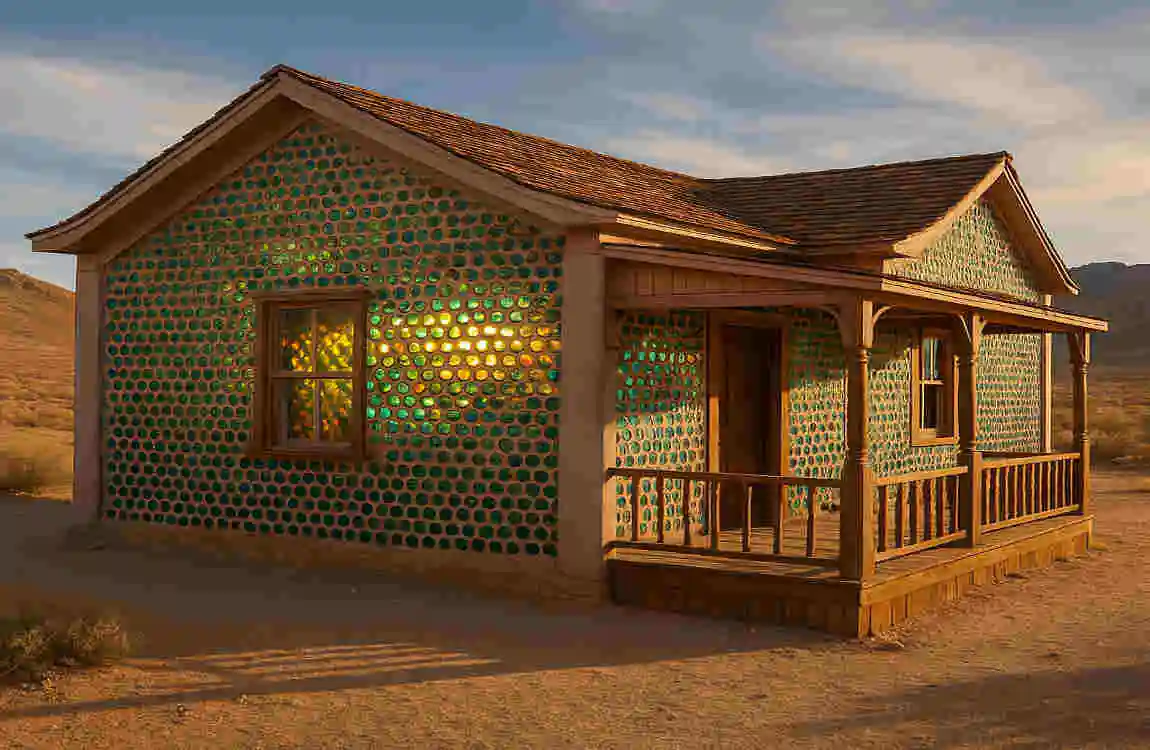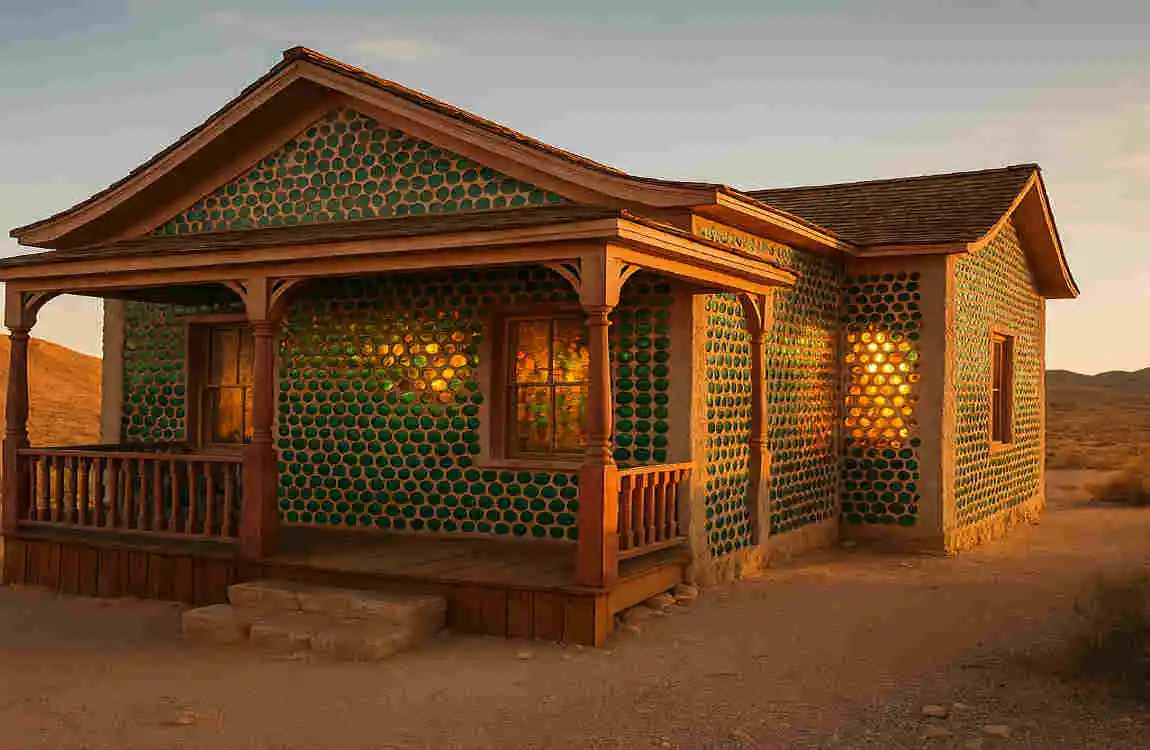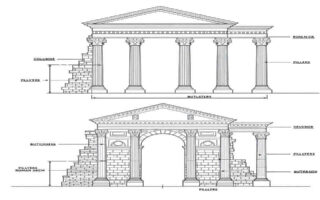Hey there! Have you ever stumbled upon something so unique that it just stops you in your tracks? Well, that’s precisely what the Tom Kelly Bottle House does to anyone who hears about it or gets the chance to see it in person. Imagine a house built not with bricks or wood, but with thousands of glass bottles shimmering in the sunlight, creating a kaleidoscope of colors and patterns. It’s not just a building; it’s a statement, a piece of art, and a bold step toward sustainability. Located in Rhyolite, Nevada, this quirky structure has captured the imagination of architects, environmentalists, and curious travelers alike.
Whether you’re into architecture, eco-friendly living, or love a good story about thinking outside the box, there’s something here for you. So, let’s unpack the inspirations, the process, and the lasting impact of this incredible structure. Stick with me as we explore why this bottle house isn’t just a building but a symbol of creativity and sustainability.
Why does this matter, you ask? In a world where we’re constantly looking for ways to reduce waste and live more sustainably, the Tom Kelly Bottle House stands as a shining example of what’s possible when we rethink everyday materials. It’s a reminder that innovation doesn’t always mean high-tech solutions; sometimes, it’s about seeing the potential in what’s right in front of us. Ready to learn more? Let’s get started!
Background on Tom Kelly and His Bottle House

Who Was Tom Kelly?
Let’s begin with the man behind the marvel—Tom Kelly. Not much is widely documented about his personal life, but what we do know paints a picture of a resourceful and creative individual. Tom Kelly wasn’t a trained architect or a professional builder. He was a prospector, a man of the early 20th century, living in the rugged desert of Nevada during the gold rush era. Back then, in the early 1900s, Rhyolite was a bustling mining town, and Kelly was just one of many trying to make a living in a harsh environment.
You may also read (unlocking success am home architecture acceptance insights).
What sets him apart, though, is his ingenuity. With no formal training, Kelly had a knack for problem-solving and a vision that went beyond the ordinary. His decision to build a house out of bottles wasn’t just a whim; it was a reflection of his practical mindset and a response to the world around him. This brings us to the heart of his legacy—the Tom Kelly Bottle House.
The History of the Bottle House
The Tom Kelly Bottle House was constructed in 1906 in Rhyolite, Nevada, a town that, at the time, was booming with miners and dreamers chasing gold. But resources were scarce, and building materials like wood or stone were either expensive or scarce in the desert. Kelly built his house during a time when innovation wasn’t just appreciated—it was necessary for survival.
When the house was first completed, it must have turned heads. Imagine walking through a dusty mining town and suddenly spotting a structure made of glass bottles, catching the light and standing out against the barren landscape. It wasn’t just a home; it became a local landmark almost instantly. Though Rhyolite turned into a ghost town as the gold rush faded, the bottle house endured, preserved as a piece of history and a testament to human creativity.
Key Features of the Tom Kelly Bottle House
So, what makes the Tom Kelly Bottle House so special? For starters, it’s built using around 50,000 glass bottles—mostly beer and whiskey bottles collected from local saloons. These bottles aren’t just decorative; they form the very walls of the house, embedded into mortar to create a sturdy structure. The result is not only functional but also visually stunning, with the glass creating a mosaic effect as light filters through.
Beyond aesthetics, the house is a three-room structure with a practical design suited to the desert climate. The thick walls of bottles and mortar help insulate the interior, keeping it cooler during scorching days. It’s a clever use of materials that were essentially waste at the time, turning trash into treasure. This unique blend of form and function is why the bottle house remains a topic of fascination even over a century later.
Exploring the Inspiration Behind Using Bottles

Environmental Concerns as a Driving Force
Let’s dive into what inspired Tom Kelly to build such an unusual home. First off, while the term “sustainability” wasn’t in everyday use back in 1906, the concept was very much alive in Kelly’s mind. Living in a mining town, he saw firsthand the waste generated by saloons and businesses—empty glass bottles piling up with nowhere to go. Why let them sit as trash when they could be something more?
Kelly’s decision to use bottles for the Tom Kelly Bottle House was, in many ways, an early act of recycling. By repurposing these discarded items, he reduced waste in his community and created something worthwhile. Think about it—how often do we overlook everyday items that could serve a new purpose? Kelly’s approach challenges us to see potential where others see garbage, a lesson that’s even more relevant today as we grapple with environmental issues.
Artistic Motivation and a Vision for Beauty
Beyond practicality, there was an artistic spark in Tom Kelly’s idea. Building with bottles wasn’t just about making do with what was available; it was about creating something beautiful and unique. The way the glass catches the light, casting colorful reflections, turns the house into a piece of living art. Each bottle, with its own shape and shade, adds to a patchwork that’s as much a sculpture as it is a shelter.
Have you ever wanted to turn something ordinary into extraordinary? That’s exactly what Kelly did. His bottle house shows us that art doesn’t have to be confined to canvases or galleries—it can be part of our everyday spaces. For Kelly, the Tom Kelly Bottle House was a canvas, and the bottles were his paint, allowing him to express creativity in a way that was both functional and breathtaking.
You may also read (unveiling the secrets of mediterranean home aesthetics).
Economic and Practical Factors at Play
Let’s not forget the practical side of things. In Rhyolite, traditional building materials were either scarce or expensive. Wood had to be shipped in, and bricks weren’t exactly lying around in the desert. Bottles, on the other hand, were abundant and free for the taking. Saloons were everywhere in a mining town, and empty bottles were a byproduct of daily life. For Kelly, using them was a no-brainer.
This choice wasn’t just about saving money, though. It was about resourcefulness. By using what was readily available, Kelly built a home without relying on distant supplies. It makes you wonder—how often do we overcomplicate solutions when the answer might be correct in front of us? The Tom Kelly Bottle House is a reminder that sometimes the best ideas come from working with what you’ve got.
Historical and Cultural Influences
Kelly didn’t invent the idea of building with bottles out of thin air. While his house is one of the most famous examples, the concept of using glass containers in construction has roots in various cultures. For instance, in some parts of Europe and Asia, bottles and jars were used in walls for both insulation and decoration long before the 20th century. Folk art traditions of upcycling—turning old items into something new—likely played a role in shaping Kelly’s thinking.
In the American West, where innovation often stemmed from necessity, such practices weren’t uncommon. Kelly may have heard stories or seen examples of makeshift building techniques during his travels as a prospector. These cultural threads, combined with his own ingenuity, wove together to create the Tom Kelly Bottle House, a structure that feels both timeless and tied to its specific place and time.
The Process of Building the Tom Kelly Bottle House
Design and Planning Challenges
Building a house out of bottles sounds cool, but how do you even start? For Tom Kelly, the process began with a vision and a lot of trial and error. Unlike traditional homes, there weren’t blueprints or guides for constructing something like the Tom Kelly Bottle House. Kelly had to figure out how to make glass bottles—fragile by nature—into a strong, lasting wall.
One major challenge was structural integrity. Bottles aren’t naturally load-bearing, so Kelly needed a way to hold them together securely. His solution? Mortar. By embedding the bottle’s neck-first into a thick mixture of sand and cement, he created surprisingly sturdy walls. It’s like building a puzzle, fitting each piece just right to ensure the whole thing doesn’t collapse. Can you imagine the patience that took?
Sourcing the Materials
Now, where do you get 50,000 bottles in the middle of the desert? Luckily for Kelly, Rhyolite’s saloons provided a steady supply. In a mining town, alcohol was a staple, and empty beer and whiskey bottles were discarded daily. Kelly collected these over time, likely with help from locals who were happy to see the clutter cleared away.
This part of the story shows just how connected the Tom Kelly Bottle House is to its environment. The materials weren’t imported or manufactured; they were a direct product of the town’s daily life. It’s a beautiful example of working with what’s around you. Next time you’re tossing out a bottle, maybe pause and wonder—what could this become?
Construction Techniques
The actual building process was labor-intensive. Kelly laid the bottles in rows, embedding their necks into wet mortar while leaving the bottoms exposed to create the outer wall. This method not only held the bottles in place but also created a striking visual effect, with the glass bottoms acting like tiny windows that let light filter through.
To ensure the house would stand the test of time, Kelly paid attention to the mix of mortar, making it strong enough to withstand the desert’s harsh weather. He also built the walls thickly to provide insulation against the heat. It’s fascinating to see how much thought went into something that, at first glance, might seem like a whimsical idea. The Tom Kelly Bottle House proves that creativity and practicality can go hand in hand.
Impact of the Tom Kelly Bottle House
Architectural Significance
When it comes to architecture, the Tom Kelly Bottle House is a standout. It’s not just a quirky building; it’s a pioneer in the realm of alternative construction. At a time when most homes were built with standard materials, Kelly’s creation showed that you could break the mold—literally and figuratively—and still create something functional and beautiful.
This house challenges the way we think about building design. It’s a precursor to modern green architecture, where recycled materials are often used to create eco-friendly spaces. Architects and designers today look at Kelly’s work and see a spark of genius, a reminder that innovation doesn’t always need fancy technology. Have you ever considered how the buildings around you could be reimagined with unconventional materials?
Tourism and Community Influence
Even though Rhyolite became a ghost town after the gold rush, the Tom Kelly Bottle House has kept its spirit alive. Today, it’s a tourist attraction, drawing visitors from all over who want to see this oddity for themselves. Restored and maintained by local historical societies, the house stands as a symbol of the town’s past and a point of pride for the community.
It’s more than just a photo op, though. The bottle house brings people together, sparking conversations about history, creativity, and sustainability. Locals and tourists alike leave inspired, thinking about how they can apply similar ideas in their own lives. Isn’t it amazing how one man’s idea can ripple out and touch so many people, even decades later?
Environmental and Educational Messages
One of the most significant impacts of the Tom Kelly Bottle House is its environmental message. Long before “reduce, reuse, recycle” became a mantra, Kelly was living it. His house shows that waste doesn’t have to be the end of a material’s story—it can be the beginning of something new. This idea resonates strongly today as we face challenges like overflowing landfills and climate change.
The house also serves as an educational tool. Schools, environmental groups, and curious individuals visit or study it to learn about sustainable building practices. It’s a hands-on example of how to think differently about resources. So, what can you learn from this? Maybe it’s time to look at the “trash” in your life and see the potential for something greater.
Legacy of Tom Kelly’s Work
Tom Kelly may not have set out to change the world, but his bottle house has left a lasting mark. It’s inspired other builders and artists to experiment with recycled materials, from bottle walls in modern homes to entire structures made of reclaimed goods. His legacy is one of creativity and sustainability, showing that anyone, anywhere, can make a difference with a bit of ingenuity.
The Tom Kelly Bottle House encourages us to rethink what’s possible. It’s a call to action for future generations of architects, dreamers, and everyday folks to push boundaries and care for the planet. What’s your next big idea? Could it be as groundbreaking as a house made of bottles?
Lessons Learned from Tom Kelly’s Bottle House
Creative Ingenuity in Action
One of the biggest takeaways from the Tom Kelly Bottle House is the power of creative thinking. Kelly didn’t have a degree in architecture or a big budget, but he had an idea and the determination to make it work. He looked at something as mundane as a glass bottle and saw a building block. That kind of ingenuity is something we can all tap into, whether we’re designing a home or solving a problem at work.
Sustainability as a Core Principle
Another lesson is the importance of sustainability. Kelly’s house isn’t just a cool design; it’s a model for eco-friendly living. By reusing materials that would have been thrown away, he minimized waste and created something enduring. In today’s world, where every little bit helps, this approach feels more urgent than ever. So, how can you incorporate sustainable practices into your life? Start small, like repurposing items at home.
Inspiration for Future Projects
Finally, the Tom Kelly Bottle House inspires us to dream big. It shows that unconventional ideas can lead to incredible results, encouraging architects and artists to rethink waste and resources. Whether you’re a builder or just someone with a creative streak, Kelly’s story is a nudge to experiment and innovate. What’s stopping you from trying something out of the ordinary?
Conclusion and Final Thoughts
As we wrap up this journey through the story of the Tom Kelly Bottle House, it’s clear that this isn’t just about a quirky building in the Nevada desert. It’s about vision, resourcefulness, and a deep connection to the environment. Tom Kelly’s inspiration—whether driven by necessity, artistry, or a desire to reuse what others discarded—resulted in a structure that continues to captivate and educate over a century later.
The importance of sustainable and artistic architecture can’t be overstated. In a time when we’re searching for ways to live lighter on the planet, the bottle house stands as a beacon of what’s possible. It challenges us to look at the world differently, to see potential in the overlooked, and to create with purpose.
I encourage you to explore more about creative and sustainable building methods. Maybe visit the Tom Kelly Bottle House if you’re ever near Rhyolite, or start rethinking the materials around you. What could you transform into something new? I’d love to hear your thoughts—drop a comment below or share your own ideas for eco-friendly projects. Let’s keep this conversation going and inspire each other to build a better, more imaginative future!
You may also read (why was the rodanthe house moved inland from the beach).




